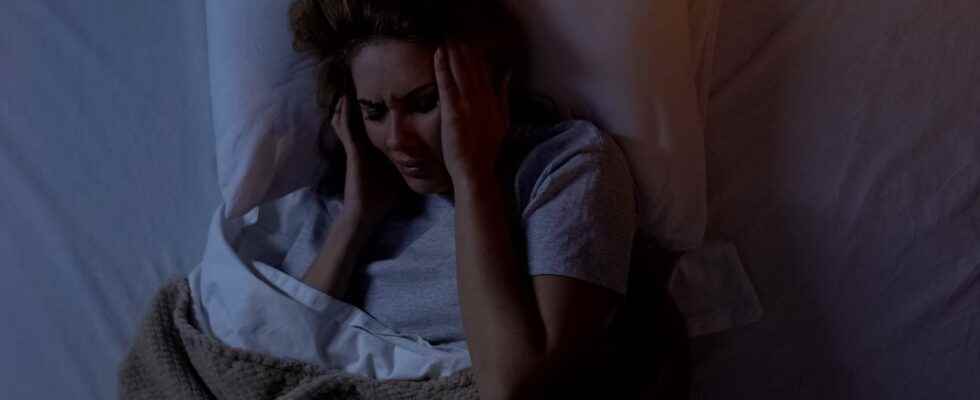It is known that our circadian rhythm, set over approximately 24 hours, regulates our sleep, our cognitive abilities, our memory… A team of researchers has just shown that sensitivity to pain is also controlled by our internal clock, with a peak of maximum intensity felt at night, between 3 and 4 am, and a minimum in the afternoon. A promising discovery for pain management.
You will also be interested
[EN VIDÉO] Reduce pain with a magnetic field? In this Inserm video, from the “Black Box” series, pain is presented as a nervous process controlled by the brain. The film shows an experimental method aimed at reducing pain in patients using a targeted magnetic field applied to specific areas of the brain.
The level of activity of many body functions is regulated by a internal clock set to a rhythm of approximately 24 hours: the sleep/wake system, the body temperature, blood pressure, hormone production, heart rate, but also cognitive abilities, mood and memory. To this long list, we can now add the pain. The team of Inserm researcher Claude Gronfier at the Lyon Neuroscience Research Center (Inserm/University Claude Bernard Lyon 1/CNRS), has just shown that this is also the case. These works appear in Brain.
Pain intensity follows a sinusoidal curve over 24 hours with maximum intensity between 3 and 4 a.m. and minimum around 3 and 4 p.m., independent of behavior and any external environmental factors. .
A study of young adults kept awake for 34 hours
To highlight this, the researchers studied twelve young adults in the laboratory under conditions ofinsulation temporal and of constant routine. They kept them awake for 34 hours without any external signal or environmental rhythm reaching them: no timetable, no meal at a fixed time but a snack every hour, a temperature and a weak brightness constant, no change in posture (semi-lying position) and no activity/rest rhythm. The objective was to assess whether painful perception was rhythmic under these conditions, so that it could be concluded that it was controlled by the internal clock.
In this situation, the researchers exposed the participants’ forearm to a source of heat every two hours. On the one hand, the participants had to indicate when the stimulus became painful during the increase in temperature, and on the other hand, they had to rate the intensity of the pain on a scale of 1 to 10 during theapplication with a temperature of 42, 44 or 46 degrees Celsius. Two complementary approaches intended to check the consistency of the results.
The researchers observed in all the subjects a rhythmicity of the painful sensation, during the 24 hours
The researchers observed in all the subjects a rhythmicity of the painful sensation, during the 24 hours. “The results are very homogeneous with an extremely significant association”, explains Claude Gronfier. In addition, they found, as claimed by previous work without having demonstrated it, that the sensitivity to pain increased linearly with the debt of sleep : the greater the sleep debt, the greater the intensity of the pain felt. “It is often said that the sleep has an action analgesic. But by modeling our results mathematically, we show that the internal clock is responsible for 80 % change in pain sensation over 24 hours, compared to only 20 % for sleep »he clarifies.
Maximum intensity in the middle of the night
This circadian variation of pain certainly has a physiological utility according to Claude Gronfier. “We don’t know why the sensitivity is highest in the middle of the night. We can think that evolution has put this in place in order to be awakened quickly in the event of painful contact and to avoid a vital threat. During the day, the individual is aware of the surroundings and more easily prone to injury; this warning signal could therefore be less necessary. » This discovery is part of the concept of personalized medicine, and more precisely of circadian medicine. This is emerging and takes account of biological rhythms in patient care.
“According to these results, it is legitimate to think that improving the synchronization of biological rhythms and/or the sleep quality in individuals suffering from chronic pain could contribute to better therapeutic managementbelieves Claude Gronfier. Furthermore, just like the chronotherapy of cancer has proven itself with better efficacy and reduced toxicity when drugs are administered at certain times of the day, adapting an analgesic treatment according to the same process, taking into account the biological rhythm of each individual, could increase its efficacy while reducing the necessary dose and potential adverse effects. However, this hypothesis remains to be validated by clinical tests before being able to offer this chronobiological approach to patients”he warns.
A desire to escape for the summer?
To celebrate the holidays as it should be, discover the Mag Futura at the preferential price of €15 instead of €19, i.e. a reduction of 20% !
On the program of this issue: a dive into the heart of 4 scientific themes that will mark 2022, from the Earth to the Moon:
- What mysteries does the Moon still hide from us?
- Will we soon be able to cure everything thanks to genes?
- How to feed the world without destroying it?
- Can artificial intelligence become truly intelligent?
What is Mag Futura?
- Our first paper journal of more than 200 pages to make science accessible to as many people as possible
- 4 major scientific questions for 2022, from the Earth to the Moon
- Home delivery*
*Delivery is made in France (excluding metropolitan France), Switzerland, Belgium.
Interested in what you just read?
